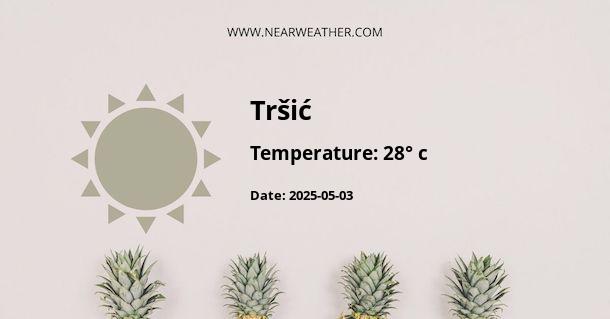An In-Depth Look at Tršić, Serbia: Understanding the Climate and Weather Patterns Year Round
Tršić is a village in Serbia, renowned for being the birthplace of the Serbian language reformer Vuk Stefanović Karadžić. Located near the city of Loznica, in the western part of the country, Tršić is not only steeped in cultural history but also features a distinctive climate that shapes the experiences of residents and visitors alike. To understand Tršić's weather, it's imperative to delve into its climatic classification, seasonal variations, and the impact that broader weather patterns have on this region.
Climatic Classification of Tršić
Tršić exhibits a humid continental climate, characterized by large seasonal temperature variances and a significant precipitation spread throughout the year. This is classified under the Köppen climate classification as "Dfb." This classification implies warm summers, cold winters, and no dry season, which is typical for inland Serbia and the Balkan Peninsula.
Temperature Patterns and Seasonal Variations
Winter
The winter months in Tršić can be quite chilly, with average temperatures often dropping below freezing. Snowfall is common and can lead to picturesque landscapes, making it a delightful time for winter photography and cultural exploration, despite the cold.
- January: The coldest month with average low temperatures often dropping to -3°C (26.6°F).
- February: Slightly warmer than January but still quite cold with similar snowfall patterns.
Spring
Spring brings a gradual warming trend, with flora and fauna awakening as the snow melts away. Precipitation increases, often in the form of rain, which nourishes the green rolling hills of the region.
- March: Transitioning month with temperatures rising but still experiencing some late snow or frost. The average high can reach up to 10°C (50°F).
- April and May: Marked temperature improvement can be noted, with more consistent rainfall.
Summer
Summers in Tršić are warm and pleasant, making it an excellent time for outdoor activities and exploring the natural beauty of the surrounding landscapes.
July stands out as the warmest month, with temperatures occasionally climbing above 30°C (86°F). These conditions are conducive to agricultural practices and tourism alike.
- June: Marks the start of warmer weather with longer days.
- August: Similar to July but begins the transition toward cooler autumnal weather as the month ends.
Fall
Fall sees a steady decline in temperature, with a noticeable shift in the ecosystem as leaves change color, and the harvest season begins.
- September: Still relatively warm, especially in early September, with daytime highs averaging around 20°C (68°F).
- October and November: Noticeable cooling occurs as winter approaches, with increased chances of frost and fog especially in the mornings.
Precipitation and Humidity
Precipitation in Tršić is fairly evenly distributed throughout the year, with no distinct dry season. The village experiences an average annual rainfall of around 700-800 millimeters (27.5 - 31.5 inches).
Most of the rainfall occurs during the warmer months, with convective showers and thunderstorms being quite common. Spring and early summer typically register the highest rainfall amounts, contributing to the lush green landscapes characteristic of this region.
Expected Weather Challenges
Despite the general pleasantness of Tršić's climate, there can be weather-related challenges that are worth noting:
- Flooding: Due to the significant amounts of rainfall, particularly in spring and early summer, certain areas may experience flooding.
- Snow and Ice: During winter, snow and ice can disrupt transportation and lead to increased risk of accidents.
- Summer Heatwaves: While not excessively common, heatwaves can occur during the summer, leading to discomfort and health risks for vulnerable populations.
Annual Weather Patterns
The weather in Tršić is influenced by larger meteorological dynamics such as the continental and Mediterranean air masses. This confluence of air masses can lead to rapid weather changes and can affect local weather patterns unexpectedly. Annual weather cycles are, however, generally consistent, with the Balkan region experiencing four distinct seasons.
Climate Change Considerations
In the face of global climate change, Tršić, like many other places worldwide, might experience shifts in its historic weather patterns. This could manifest in more extreme weather events, such as hotter summers, colder snaps in winter, and more intense precipitation events. Continuous research and monitoring are necessary to understand and respond to these potential changes effectively.
Conclusion
Tršić's climate and weather patterns are distinctive, with a full range of seasonal changes offering different experiences for residents and visitors throughout the year. From the snowy, serene winters to the warm, vibrant summers, understanding Tršić's meteorological dynamics is essential for anyone planning to visit or explore the region's deep cultural heritage. With climate change on the horizon, maintaining awareness of the evolving weather trends in Tršić becomes ever more critical. Whether you're drawn to Tršić by its historical significance, its beautiful natural landscapes, or the charming local climate, it is a village that leaves a lasting impression.
A - Tršić's Latitude is 44.508060 & Longitude is 19.268890.
A - Weather in Tršić is 3° today.
A - Climate Conditions in Tršić shows overcast clouds today.
A - Humidity in Tršić is 71% today.
A - Wind speed in Tršić is 5.08 km/h, flowing at 248° wind direction. today.
